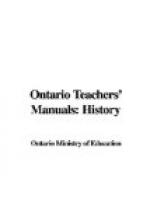1. In the tenth century, Malcolm I obtained Strathclyde (see map, Ontario Public School History of England, p. 27) as a fief from Edmund of England. His grandson, Malcolm II, was invested with Lothian, before this a part of the English earldom of Northumbria. These fiefs are the basis of all claims afterwards made by English kings as overlords of Scotland.
2. Malcolm III (1057-1093) married Margaret, sister of Edgar Atheling. The Norman conquest drove many Saxons north, and the Saxon element in Scotland was strengthened by this.
3. William the Conqueror compelled Malcolm’s submission, 1072. This kept alive the English claims.
4. Henry I married Matilda of Scotland. Many Normans went to Scotland in the reign of David (1124-1153). The Feudal System was introduced and firmly established under Norman influence. Ecclesiastical foundation begun. Friendly relations strengthened.
5. As the price of his liberty, William the Lyon agreed, by the Convention of Falaise, 1174, to hold Scotland as a fief of England.
6. To raise money for his Crusade, Richard I of England renounced, in 1189, his feudal rights over Scotland for 10,000 marks, and for the first time acknowledged her independence.
7. The border line was fixed for the first time in 1222.
8. The death of Margaret, daughter of Alexander III, 1286, left the crown a bone of contention; Balliol finally secured it by favour of Edward I of England, the overlord of Scotland. Then followed the War of Independence under Wallace and Bruce and the Battle of Bannockburn, 1314. This long and destructive war caused the Scots to have a deadly hatred of the English, and drove Scotland into alliance with France, the great enemy of England, and consolidated the different races in Scotland.
9. Scotland thus became involved in the many wars between England and France and attacked England whenever she and France were at war.
10. In 1327, the independence of Scotland was acknowledged.
11. Friendship with France and distrust of England continued well into the Reformation period, and in the main determined Scotland’s foreign policy.
12. With the change of religion in Scotland at the Reformation, French influence came to an end. Religious sympathy overcame the political hatred of England.
13. The trouble in connection with Mary Queen of Scots and her imprisonment made for peace between the two countries, as Scotland did not want to have Mary released for fear of further civil war.
14. The accession of James VI, a Scottish king, to the throne of England, ended almost entirely the differences between the two countries, and led finally to the Legislative Union a century later (1707).
ANALYSIS OF SECTIONS 160-170, ONTARIO PUBLIC SCHOOL HISTORY OF ENGLAND
The Parliament had already established its sole right to levy taxation. (See Green’s Short History of the English People, p. 478.) Under Charles I the struggle was mainly about the manner in which the taxes should be spent; in other words, the Parliament was trying to secure control of the executive, the other important element in Responsible Government.




